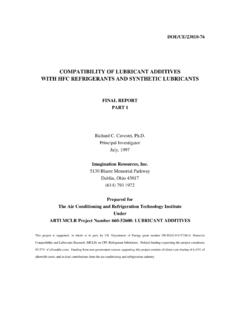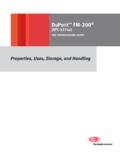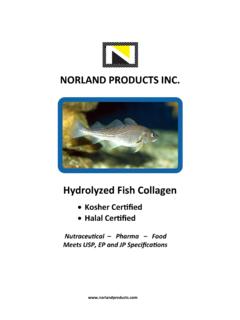Transcription of DESIGN MANUAL HFC-125 Extinguishing System …
1 DESIGN MANUAL . HFC-125 . Extinguishing System 42 bar Bettati Antincendio Via Cilea 1 42100 Reggio Emilia . Tel.+39 0522 300705 Fax +39 0522791052. Website: Email: 1. CONTENTS. SECTION 1 Introduction .. 4. Scope and purpose of MANUAL ..4. Terminology and Contacts ..5. Standards and Code of practice ..6. Approval / Certification of agent ..6. SECTION 2 Use and Limitations of Extinguishing agent HFC-125 .. 7. Introduction ..7. Extinguishing agent HFC-125 chemical and physical properties..7. Extinguishing Agent HFC-125 Hazards to personnel (Reference: ISO-14520) ..9. Safe Exposure Guidelines for Halocarbon Agents ..10. Safety precautions for Hazard to environment ..12. Hazard from electrostatic discharge in igniting flammable SECTION 3 Basis of HFC-125 Systems DESIGN .
2 13. Hazard Analysis ..13. DESIGN Required Agent Additional Altitude Correction Discharge Time ..17. Duration of Protection ( Door Fan Test ) ..17. System DESIGN Pre-Engineered Systems Concept ..18. Engineered Systems Modular Systems ..18. Central Storage Systems ..19. Container Locations ..19. Nozzle selection and location ..20. Tee Orientation ..21. Pipework and Estimating Pipe Pipes Hangers and Support ..23. DESIGN example calculation according to ISO 14520 part 8 Next Calculations with Flow Calculations with Hughes Associates Inc..28. 2. SECTION 4 System Components .. 35. HFC-125 Container ..35. Fixing Halocarbon agents Halocarbon Valve with MANUAL solenoid Pressure switch and gauge removable device ..37. Discharge flexible hose ..37. Manifold bracket Halocarbon agents manifold check valve.
3 38. Directional valve ..38. Flexible Pilot Male Tee ..39. Discharge Pressure Switch ..39. Halocarbon agents Discharge Nozzle ..39. 3. 1 Introduction Scope and purpose of MANUAL This MANUAL is a comprehensive guide containing all recommendations necessary to DESIGN and install the HFC-125 Gas Extinguishing System . In this MANUAL System refers to the Extinguishing equipment and does not include any electrical System which may initiate an agent release. Furthermore the MANUAL includes some information about HFC-125 chemical and physical characteristics, and contains DESIGN technical specifications and safety requirements. Working pressure of designed systems is 42 bar. Users of this MANUAL are assumed to be competent fire engineers with a basic knowledge of such systems.
4 Terminology and Definitions For the purposes of this MANUAL the following terms and definitions apply: -Approved: acceptable to a relevant authority. NOTE in determining the acceptability of installation or procedures, equipment or materials, the authority may base acceptance on compliance with the appropriate standards. -Authority: organisation, office or individual responsible for approving equipment, installation or procedures. -Automatic/ MANUAL switch: means of converting the System from automatic to MANUAL actuation. NOTE This may be in the form of MANUAL switch on the control panel or other units, or a personnel door interlock. In all cases, this changes the actuation mode of the System from automatic and MANUAL to MANUAL only or vice versa. -Extinguishant: electrically non-conducting gaseous fire extinguishant that does not leave a residue upon evaporation.
5 - Extinguishing Concentration: minimum concentration of extinguishant required to extinguish fire involving particular fuel under defined experimental conditions excluding any safety factor. -Engineered System : System in which the supply of extinguishant stored centrally is discharged through a System of pipe and nozzles in which the size of each section of pipe and nozzle orifice has been calculated in accordance with relevant parts of ISO 14520. - DESIGN Concentration: concentration of extinguishant, including a safety factor, required for System DESIGN purpose. -Maximum Concentration: concentration achieved from the actual extinguishant quantity at the maximum ambient temperature in the protected area. 4. -Maximum Working Pressure: equilibrium pressure within a container at the maximum working temperature.
6 -Fill density: mass of extinguishant per unit volume of container. -Liquefied gas: gas or gas mixture (normally a halocarbon) which is liquid at the container pressurization level at room temperature (20 C). -Non Liquefied Gas: gas or gas mixture which, under service pressure and allowable service temperature conditions, is always present in the gaseous form. -Flooding Quantity: mass or volume of extinguishant required to achieve the DESIGN concentration within the protected volume within the specified discharge time. -Protected Volume: volume enclosed by the building elements around the protected enclosure , minus the volume of any permanent impermeable building elements within the enclosure. -Hold Time: period of time during which a concentration of extinguishant greater than the fire Extinguishing concentration surround the hazard -LOAEL (lowest observed adverse effect level): lowest concentration at which an adverse toxicological or physiological effect has been observed.
7 -NOAEL (no observed adverse effect level): highest concentration at which no adverse toxicological or physiological effect has been observed. -Normally Unoccupied Area: area not normally occupied by people but which may entered occasionally for brief periods. -Selector Valve: valve installed in the discharge piping downstream of the extinguishant containers, to direct the extinguishant to the appropriate hazard enclosure. -Total Flooding System : System arranged to discharge extinguishant into an enclosed space to achieve the appropriate DESIGN concentration. Contacts Technical data of this MANUAL are given for information only. Bettati Antincendio ensures that information contained in this MANUAL are careful and disclaims all responsibility about a not correct use of data here displayed.
8 If you cannot understand any part of this MANUAL , or you have any queries concerning a System , please contact : BETTATI ANTINCENDIO. Via Cilea 1. 42100 Reggio Emilia Tel. +39 0522 300705. Fax. +39 0522 791052. 5. Standards and Code of practice Systems that use Extinguishing agent HFC-125 are designed according to these standards: UNI 10877-8 (Italian Body Standard April 2000);. ISO 14520 part 1 Gaseous media fire Extinguishing systems Physical properties and System DESIGN Part 1: General requirements First Edition. ISO 14520 part 8 Gaseous fire Extinguishing System physical properties and System DESIGN First Edition. ISO 14520 part 1 Gaseous media fire Extinguishing systems Physical properties and System DESIGN Part 1: General requirements Next Edition. ISO 14520 part 8 Gaseous fire Extinguishing System physical properties and System DESIGN First Edition.
9 2000 Edition NFPA 2001 Clean agent fire Extinguishing System . Approval / Certification of agent HFC-125 was approved as an Extinguishing gas by : EPA (Environmental Protection Agency USA). UL (Underwriters Laboratories). 6. 2 Use and Limitations of Extinguishing agent HFC-125 . Introduction The DESIGN , installation, service and maintenance of gaseous fire- Extinguishing systems HFC-125 shall be performed by competent person in fire Extinguishing System technology. Total flooding fire- Extinguishing systems are used primarily for protection against hazards that are in enclosures or equipment that, in itself, includes an enclosure to contain the extinguishant. The following are typical of such hazards, but the list is not exhaustive: Electrical and electronic hazards.
10 Telecommunications facilities;. Flammable and combustible liquids and gases;. Other high-value assets. Extinguishing agent HFC-125 chemical and physical properties. Pentafluoroethane ( HFC-125 ) is a safe, clean, and electrically nonconductive agent. HFC-125 demonstrates the closest physical property match to Halon 1301 in terms of both flow characteristics and vapour pressure. HFC-125 extinguishes fires by both physical and chemical means. Primarily, it raises the total heat capacity of the environment to the point that the atmosphere will not support combustion. In practice, however, extinguishment occurs at concentrations less than the theoretical heat capacity value. This is explained by assuming that the agent also removes the free radicals that serve to maintain the combustion process.








